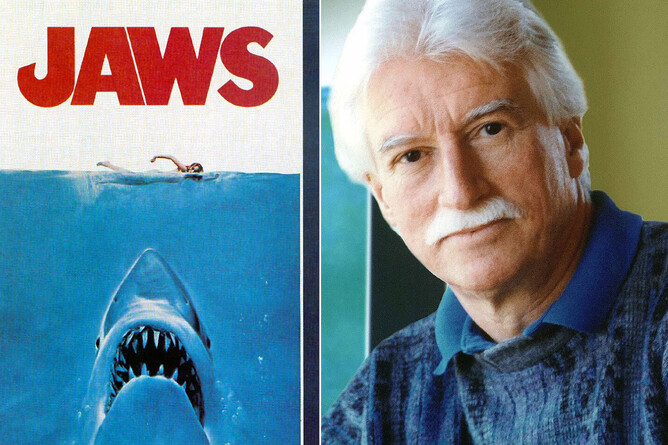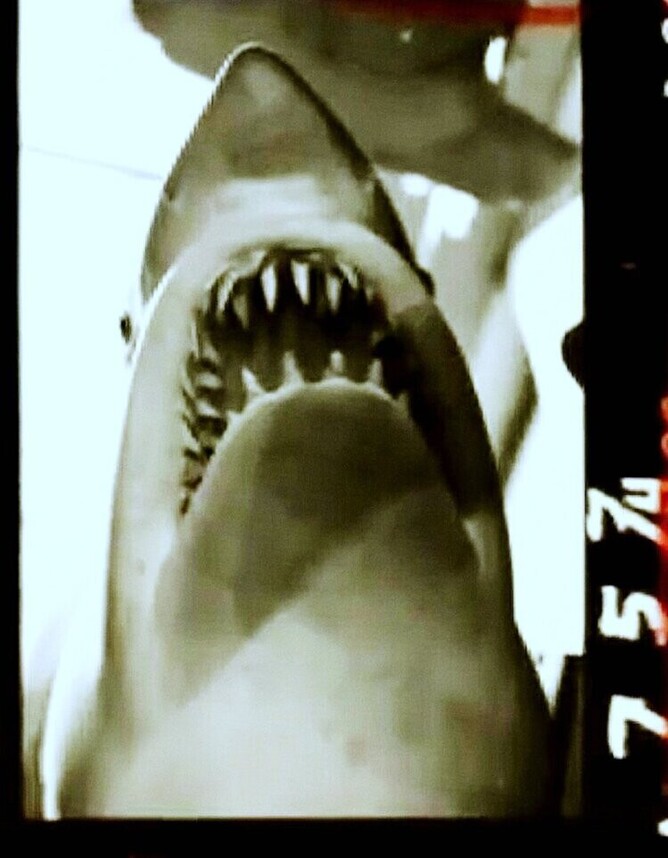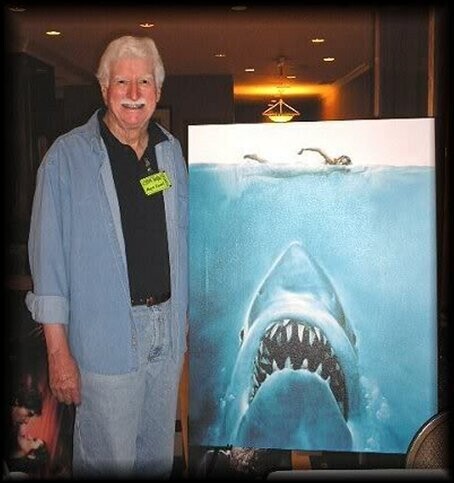The shark on the poster isn't a Great White
It’s arguably one of the most iconic images in cinematic film history, depicting a huge great white shark swimming up to an unsuspecting swimmer, Chrissie Watkins, the first victim in the Steven Spielberg ground breaking movie JAWS.
But did you know it isn't a Great White shark, its actually a Mako?
The person responsible for the creation of the now iconic image is Roger Kastel, an American artist.
Kastel was in the offices of publisher Bantam in 1974 when boss Oscar Dystel handed him a copy of the Peter Benchley thriller and said to him ‘It’s going to be a best-seller’. Kastel headed over to the American Museum of Natural History and took a few photos of stuffed sharks waiting to be cleaned.
The Mako sharks were laying on their side, but in the finished artwork Roger positioned the shark as if it is rising through the water.
Recognise those jagged teeth?
The great white belongs to the Family Lamnidae (the mackerel sharks), which includes mako and salmon sharks. The Lamnidae are large, fast-swimming sharks, found in oceans worldwide. The name of the family is formed from the Greek word, lamna, which means fish of prey, and was derived from the Greek legendary creature, the Lamia.
The name makō comes from the Maori word for shark, a Southern Maori dialect form of the more standard mangō (“shark”). The Mako is also the world's fastest shark, clocking in at speeds of up to 45mph, giving it the nickname of the cheetah of the sea.
Kastel began reading the book and didn’t have to go beyond the first few pages to find the most arresting passage — when young Chrissie Watkins goes skinny-dipping off the coast of Amity, a fictional Northeast resort town, and becomes victim number one for a massive great white shark.
Inspired that it would make a great visual he made a very rough sketch for Bantam art director Len Leones who asked him to make the shark larger and more realistic before approval of the design.
For the swimmer, a photographer friend suggested 24-year-old Wilhelmina model Allison Maher and the shoot became one of her first jobs. Kastel had Maher lay across two stools to simulate the swimming motion of the unsuspecting Chrissie, showcasing what we all would see in the opening minutes of the film. It's a terrifying moment you will never forget when Chrissie is being attacked, and so began a life long fear of sharks for a huge percentage of the population.
Allison Maher - The Jaws poster model
Kastel painted oil on Masonite, and the “Jaws” image didn’t take him long to complete. It was likely one of three paintings he completed that month.
For her stint on the stools Maher was paid just $35. Speaking afterwards to the New York post Alison said “I knew it was a book cover and that was it, If you know me, you can tell it’s me."
The Kastel design was originally for the paperback version of the book but Bantam allowed the filmmakers to use the paperback’s image as the movie poster, free of charge. The only alteration was to strategically position sea foam over the swimmer’s bare breasts.
Upon its completion, the work toured bookstores assisting in sales (some 6 million copies by late 1975), and made other appearances before finally disappearing, its location still unknown to this day.
Roger’s reputation as a top flight illustrator made its way to Hollywood, and he was later asked to paint the movie poster for George Lucas' highly anticipated sequel to Star Wars, The Empire Strikes Back.
The movie finally went into production but from the very beginning Jaws seemed destined for disaster.
Final cost for the movie ended up being double the original budget, the 55-day shooting schedule expanded to 159 days and worst of all, the star of the film—a mechanical shark named Bruce—didn't work. Morale on the set was so low that crew members nicknamed the project "Flaws" and Universal Studios considered pulling the plug entirely.
But in fact, had it not been for those flaws in production, Jaws likely wouldn't be the masterpiece it became. The malfunctioning shark forced the young director, Steven Spielberg, to adopt a less-is-more approach (similar to that made famous by Alfred Hitchcock). Since his shark didn't work, Spielberg raised suspense with shots of moving water accompanied by the ominous notes of John Williams' score. Dum-dum … dum-dum ... dum-dum. It kept audiences stirring in their seats.
Due to the production delays, the film's release was pushed back to June. In 1975, the summer months were reserved for the studios' least regarded projects. However, after Jaws frightened test audiences, Universal used the summer to its advantage, knowing exactly how to keep people out of the water and in theaters instead. It opened with a wide release in over 400 theatres, which was uncommon at the time.
Chrissie (the first victim of Jaws) in the movie was played by former actress and stuntwoman Susan Backlinie who specialised in water stunts. Her scene took three days to shoot and required her to wear a special pair of shorts with cable hooks that allowed stunt coordinators on shore to tug and pull her as if being dragged by the shark. Meanwhile, divers beneath her pulled her under.
Susan Backlinie in stunt gear.
Jaws was groundbreaking in many ways. Aside from the film itself, audiences had never seen a marketing campaign of this magnitude. Universal spent an unprecedented $1.8 million marketing the film. Its spot ran on broadcast a record number of times in the two days leading up to the theatrical release.
Not only did the poster keep audiences out of the water, but it was also the first piece of key art to become a merchandising product. Following the film's success, T-shirts, lunch boxes and backpacks appeared featuring the famous imagery.
Director Steven Spielberg (along with the iconic John Williams score) tapped into our primal fears and allowed our imaginations to do most of the heavy lifting, leaving us terrified long after the movie is over. That is the real power of Jaws and the reason it is so beloved to this day.
Not all sharks are like Jaws, in-fact none!
If you would like to learn more about these incredible animals why not sign up for an SSI Shark Ecology program. For more information click here.
oh, and if you ever use the changing room at Aotearoa Dive you be pleased to see a copy of this iconic poster proudly on display - We love sharks!






